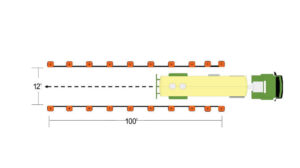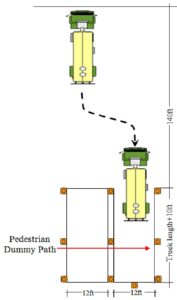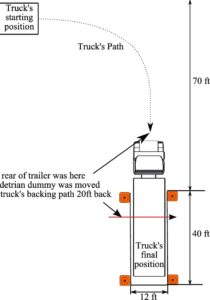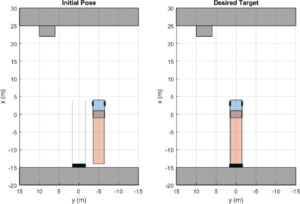In driving, there are two skills that everyone must perfect: parallel parking and backing. It is especially true for truck drivers, whose careers and safety rely heavily on these abilities. Therefore, driving tests for truck drivers place significant emphasis on these skills. The backing maneuvers portion of the skill test is particularly critical. In real-life scenarios, these abilities are vital when a driver must navigate a large vehicle into a confined space or parallel park a heavy truck with precision to avoid causing traffic disruptions.
It is crucial to comprehend the fundamental ideas and then finish practicing under the guidance of an experienced trainer to master the skill of backing your large trucks safely and conveniently. In this article, we will talk about types of backing maneuvers, guide about essential moves, and provide insightful advice to help drivers master these skills to move toward a successful truck driving career.
Types of Backing Techniques
The backing maneuvers tested in the CDL exam usually consist of four primary maneuver types: alley dock, parallel park, offset backing, and straight back. Each technique has its own set of rules and can be challenging at times. Drivers must demonstrate that they can back the massive truck even in limited spaces while abiding by the regulations and ensuring safety. The different types of backing maneuvers are explained below.
Straight Line Backing
Regarded as the easiest backing maneuver, the straight back can still be challenging for rookie drivers, especially under the pressure of the test. You have to trust your training and drive forward in a straight line and then reverse the vehicle in a straight path without running into any corners or crossing predetermined boundaries.

As easy as it sounds, driving straight back is challenging if you have limited visibility from your seat in the large truck. During this time, you must be completely alert to ensure the vehicle’s rear stays on the track and avoids obstacles.
Offset Backing
During the test, the examiner will ask you to move forward and back to park in a lane on the left or right side. This maneuver is called offset backing. The challenge is precisely executing the backing motion while remaining within the designated parameters.

This move assesses your ability to control the trailer’s trajectory and appropriately align it within the allotted space. You must be able to read the vehicle you drive and understand how the trailer responds to steering movements while reversing. In addition to staying between the lines, you must ensure the trailer travels in a controlled and smooth manner with minimal deviations.
Alley Dock
Generally speaking, the alley dock is one of the most challenging backing maneuvers. It requires you to move forward, maintain position inside the designated cone-shaped borders, and back the truck into an appointment to the left, usually at a 90-degree angle to the driver. This backing technique is beneficial in a short alley or a loading dock, which are usual places a truck might occasionally have to back into.

The trailer’s swing must be controlled while backing up, and the driver must carefully assess the angles and distances with a high degree of precision. It will ensure the proper alignment of the vehicle and trailer within the designated area without running into cones or stepping over boundary lines.
Parallel Parking
The last and possibly most challenging backup technique is parallel parking, which requires placing the truck parallel to a designated area. The truck occupies a much larger space, so more awareness about spatial adjustments is needed. It is challenging because parking must be done on the left or right sides.

Before completing the parallel backing maneuver, the driver must inspect the assigned parking area to ensure the truck and trailer fit comfortably inside the designated space. The similar parking technique shows the driver’s skill and expertise in controlling the truck’s movements in limited areas using on-the-spot assessment and judgments.
You also must consider various elements while backing, including vehicle blind spots, the use of mirrors, and the significance of communicating with ground workers whenever required. You must practice these maneuvers thoroughly while preparing for the test to develop confidence and skills.
Truck drivers need to learn safe driving practices, given the fatal accidents on the road, with an average of over 5000 crashes reported in 2018.
Scoring Parameters in CDL Tests
Passing the Commercial Driving License (CDL) test in a single attempt is challenging. Reports reveal that about 80% of drivers fail on the first try. During the CDL tests, the following parameters are evaluated to assign scores based on your performance on backing maneuvers: So, one must thoroughly acquire these skills during the test preparations.
- Crossing the boundary (encroachments)
- Pull-ups
- Exiting the vehicle for outside observation
- Final placement of the vehicle
Encroachments
The driver’s vehicle touches or crosses the predetermined boundary lines defining the designated testing area in encroachments. During the exam, each intrusion is regarded as a mistake.
Because they are directly related to the driver’s awareness of space and capacity to maintain control while executing backward maneuvers, encroachments are a substantial evaluation component.
In real-world driving circumstances, encroachments can signal that the driver is not precisely evaluating the position of their trucks, which could result in safety hazards and possible damage to other vehicles or property.
Recommendations: Drivers must use their mirrors and, if available, a spotter or ground crew to help them through the maneuver to reduce encroachments. Gaining expertise and practice is crucial to becoming more adept at avoiding encroachments, particularly when driving a large commercial vehicle because it requires a thorough grasp of the vehicle’s dimensions and turning radius.
Pull-Ups
A pull-up occurs when a driver stops the truck while backing up and moves forward to remove an obstruction, change their position, or realign their vehicle. Notably, halting without altering course is not regarded as a pull-up but as a brief break in the movement.
Although a single or two initial pull-ups are allowed, performing too many will be considered a mistake during the skill test. Frequent pull-ups indicate poor vehicle control and a lack of space awareness during a backward movement.
It results in more time to finish the backing maneuver, which is crucial considering the real-time driving scenarios where efficiency and safety are paramount.
Recommendations: Drivers should approach every backward movement with a clear plan, considering the position of the vehicle, the location of boundary lines, and the available space to reduce the necessity for pull-ups. Pull-ups may not be required if motions are controlled, with appropriate mirror utilization and communication with ground staff as necessary.
Exiting the Vehicle for Outside Observation
Outside observations of vehicles are essential to safe and efficient commercial driving, especially while backing. With these observations, drivers can evaluate how their truck appears from the outside concerning obstructions, lines, and the intended route of the maneuver. For the test to be practical, these observations must be carried out appropriately and safely to prevent potential risks.
The following crucial factors need to be considered when performing outside vehicle observations:
Security: Ensure the vehicle is in neutral and the parking brake or brakes are engaged before getting out. This is essential to avoid unintentional vehicle movement during the observation, which could result in mishaps or damages.
Careful exit: You must get out of the truck safely. When getting out, face the truck and keep three points of contact. This is crucial to avoid slipping, tripping, or falling when getting out of the truck.
Observation objectives: External observations aim to get a precise view of the vehicle’s position concerning barriers, boundary lines, and obstacles. The driver uses this information to make accurate modifications while performing the maneuver.
Interaction: Stay in effective communication with the spotter or ground personnel. They can offer insightful advice and guidance to improve the maneuver’s safety and precision.
Final Positioning of the Truck
Maneuvering the vehicle into its final position precisely as the examiner specifies tests a commercial driver’s fundamental abilities. This is a critical examination component and deviation from the guidelines may result in a test failure. This requirement emphasizes the importance of maintaining exact control and following testing guidelines.
Placement of the vehicle in the designated position indicates good spatial awareness, efficient control over the vehicle’s movements, and the ability to follow directions precisely.
It also emphasizes how crucial it is to communicate clearly and pay close attention to all the instructions during the test. This final maneuver is essential to demonstrate the driver’s competency and preparedness for safe and responsible commercial driving by successfully performing the tricks as directed.
7 Mistakes to Avoid while Backing
Reversing a commercial vehicle has particular problems and hazards, and some errors can dramatically increase the probability of an accident. Here are some frequent reversing blunders that can lead to accidents:
Inadequate Visibility: Failure to ensure clear visibility before reversing might result in an accident. Drivers should always check their mirrors and, if required, utilize spotters to ensure no impediments or persons are in the truck’s route.
Inadequate Space Awareness: When reversing, misjudging the amount of space available might result in colliding with objects or cars. Commercial vehicles demand more incredible maneuvering room; thus, drivers must be particularly mindful of their surroundings.
High Speed: Reversing at high speeds might diminish the driver’s response time and vehicle control. For safe reversing in large vehicles, slow, controlled motions are required.
Distractions: Being distracted when reversing, whether by mobile devices, the radio, or other distractions within the cab, can cause a loss of attention and lead to an accident.
Failure to utilize Reversing Alarms or Lights: Failure to use reversing alarms or lights can be harmful, particularly in congested places. These bells and lights alert neighboring people and cars to the truck’s reversal.
Ignoring Safety Protocols: Ignoring pre-reversal safety inspections, such as going around the vehicle to evaluate the path, might result in unanticipated accidents. Before reversing, it is critical to follow all safety precautions.
Poor Spotter Communication: If spotters are utilized, poor communication with them might lead to misunderstandings and mishaps. Effective communication is essential while reversing a commercial vehicle with the assistance of spotters.
Truck drivers can considerably lower the likelihood of accidents while reversing their trucks by avoiding these blunders.
Conclusion
The backing maneuvers are part of the commercial driver’s ability to operate and position a big truck precisely and safely in various rugged circumstances. In this article, we highlighted how each maneuver has unique challenges, from keeping a straight path to accurately backing at critical angles and parallel parking.
Mastering these techniques during training and test preparation is necessary for success in the driving test. Becoming a capable and accountable commercial truck driver is essential to proficiently in these backing techniques.
James Johnson is a former truck driver who now works as a writer, specializing in the trucking industry. With over 15 years of experience on the road, James has a unique perspective on the challenges and opportunities faced by truck drivers and the trucking industry as a whole. His writing focuses on issues such as safety, regulation, and the latest industry trends. His work has been featured in several trucking publications and he has received recognition for his contributions to the industry. In his free time, James still enjoys being around trucks and often attends truck shows and other industry events.


